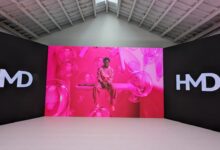HMD Global Multi-brand strategy explained: Nokia Icon is on the way

By now we all know that HMD Global, the makers of Nokia phones, will soon be launching HMD-original devices.
CEO Jean-Francois Baril in a LinkedIn post a few months ago said that the company will be expanding its portfolio with a new HMD brand in collaboration with “exciting new partners” guided by its core values, seeking collaborations that resonate with its mission.
For instance, HMD announced a partnership with Mattel and with Barbie, highlighting the joint dedication to shake things up, empower connections, and enable some quiet amidst digital noise and interruptions.
During the Mobile World Congress event held last month, the company announced its new multi-brand strategy. This new approach will enable the company to launch new HMD-branded devices, continue offering Nokia phones, and partner with other innovative partners to bring exciting new products to the market in the upcoming seasons.
HMD has recently launched three Nokia smartphones under its flagship – Nokia G22, Nokia C22, and Nokia C32. These devices come with improved imaging and durability and offer a battery life of up to three days. The Nokia G22 is the first Nokia smartphone to focus on repairability, with a global collaboration with iFixit.
What more does the HMD Global multi-brand strategy entail?
Moreover, the strategy also entails some pretty exciting elements. For example, the company says it will focus on developing more environmentally friendly devices.
This is particularly important considering the tech industry is responsible for tons of electronic waste of up to 3% of the world’s greenhouse gas emissions. The company fully moved toward sustainable packaging with all devices in its Nokia’s G-, X-, XR- and T-series that were launched after September 2022, where the accessories packaging was made of certified FSCMix materials.
This is preachy?
The Nokia X30 5G (Review) for instance, was made with a 100% recycled aluminium frame and a plastic back made with 60% recycled materials. HMD has also removed the plug as most consumers already have a compatible plug. This has helped them reduce the size of the box thus – less packaging waste and less weight to transport.
By removing the chargers from previous devices like the Nokia X10 and Nokia X20 phones, HMD claims that this move has helped save 777KG of chargers from being manufactured. However, if consumers still want a charger, they can purchase it online. For every charger purchased, €10 is donated to charity.
Finally, let’s talk affordability. HMD Global focuses on putting customer needs at the forefront. In light of this, HMD has partnered with like-minded organizations such as M-KOPA to deliver affordability, innovative payment options, and microfinancing capabilities to its customers.
In a previous interview with TechTrends Media, Joseph Umunakwe, the company’s General Manager – West, East & Central Africa reiterated that device affordability is indeed the core of their business.
‘’Affordability is something we have been driving for the past few years and that has helped us see a significant adoption of our devices in the Kenyan market’’ he said.
HMD notes that this new strategy is a big step in the company’s growth path. Having a rich portfolio will also give the company room to innovate in terms of quality and pricing, anticipating what consumers want and always putting consumers first.
We can’t wait to see what they have in store for us!
Follow us on Telegram, Twitter, and Facebook, or subscribe to our weekly newsletter to ensure you don’t miss out on any future updates. Send tips to info@techtrendske.co.ke



